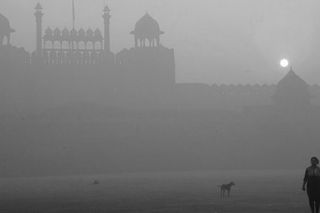
Families Are Moving to Goa to Give Their Kids Better Air
Some Delhi parents feel like the best thing they can do for their kids is leave.

There are few issues in the nation as uncontested as the air quality in New Delhi. Even the government can’t deny that the city’s pollution levels are incredibly harmful to humans (although they’re foggier — pun unintended — on who is accountable to fix it). And it’s not just Delhi: Most other big cities in India routinely experience unhealthy levels of particulate matter in the air.
Suffice to say, this is not good for the humans who live in these cities, and especially for the children. The World Health Organization recently released a report stating air pollution kills more than 7 million people globally each year. And as rural-urban migration shows no signs of slowing down in India, our cities become more and more crammed with people, and therefore, more and more polluted.
But the toxic air quality has kickstarted a reverse phenomenon: a not insignificant group of people are considering urban-rural migration.
Goa, in particular, is beginning to attract people who’ve developed chronic health issues from living in polluted cities, especially Delhi. Though much of Goa is rural, it’s not remote and has comparatively better infrastructure. One of the nation’s most prominent immunologists and clinical allergists, Dr. Anita Dudhane, practices in Goa, and many fly in from urban locales to consult her about their pollution-induced allergies and asthma. Some even decide to stay.
“My children were falling sick much too often, and I just knew that at the time, I had an option to give them a better childhood, and I had to do it.”
“It’s scary to see what that kind of particle emission does. How can you even breathe, my god?” says Dr. Dudhane. “Delhi is the worst of them, obviously. [Moving out]’s on everybody’s minds, especially because it’s so foggy and the air’s almost completely unbreathable,” she continues. “They can’t go out, they can’t step out of their homes. They’re living in air-purified homes. Going to work is a problem, going to school is a problem. And they’re most concerned about their children: Whether the kids are coughing or not, there’s a big issue with children falling sick all the time.”
Vindhya Tripathy, a self-proclaimed “pollution refugee,” left Delhi for Goa because the pollution was negatively affecting the health of her daughter, 9, and son, 6.
“It was pretty much my entire decision,” she says. “Because my family’s in Delhi, my friends, my entire life was there, so it’s not such an easy decision to make, to just decide to move. But Delhi was just much too polluted, and my children were falling sick much too often, and I just knew that at the time, I had an option to give them a better childhood, and I had to do it.”
But Dr. Dudhane notes that she hasn’t seen any kind of mass exodus out of the cities and into Goa yet. Parents are often held back because of schooling. “A lot of people don’t feel that Goa has the schools they want for their kids,” says Dr. Dudhane.
But this is changing. Top-tier schools are cropping up all over Goa, perhaps even as a result of the air pollution. While Shilpa Mehta, of the Cambridge-affiliated Paradise School, says she founded the school to meet the needs of the Goan community, including her own 14-year-old daughter, “what’s happened is the timing is such that it coincided with this onslaught of pollution in Delhi, which is escalating in seriousness,” she says. “We did get a lot of applications from families in Delhi whose children were really, really suffering. I mean, they couldn’t breathe, they couldn’t play outside, they couldn’t lead a normal childhood. And people were really looking for an alternative way of life that suited their children. So that’s why we had a huge influx of families from Delhi, basically.”
In fact, respiratory problems were so common among the Delhi children applying to Paradise School, to Mehta’s surprise, many children showed up to interviews in Goa wearing masks. “To us in Goa [that’s] like, you’re from another planet,” she says. “We could never have imagined that you’d have to live somewhere where you’d actually have to wear a mask in order to breathe properly. I mean, thankfully all the children now, in the school, have acclimatized to Goa, and they run around, and they’re on the beach, and they’re climbing trees and swimming the sea.”
Tripathy, whose children attend Paradise school, has observed that they are indeed much healthier after they’ve made the move. “I don’t like to say this too much, because I know not everyone has an option to move, and I’m very fortunate and lucky that I can move, but my kids were sick a lot, and since they’ve come to Goa, they’ve been there for seven months, they haven’t had one day of fever, illness, stomach upset, cough, cold, or anything,” she says.
While they were living in Delhi, Tripathy noticed her kids would come home very tired. But in Goa, after her kids do multiple activities, “from dance class to football to music, coming back at seven o’clock,” they still have energy. “[They’re] not exhausted, like they were in Delhi, because of the commute and the pollution in the car,” she says. “They’ve definitely become much healthier and I think, also, more environmentally aware.”
Tripathy herself feels better after the move. “I’m able to look at beautiful nature everyday. I think that has a profound effect on your wellbeing,” she says.
Mehta has noticed that effect on many of the parents at her school, but many were not fully prepared to leave their lives in the cities. “I have to make sure the parents are ready to make the move to Goa; it’s not an easy move. You don’t have the infrastructure of a city, you don’t have the employment facilities or opportunities. You have to really recreate your life from scratch, coming here,” Mehta says.
But raising a child amid Delhi-level pollution can take its own, sizeable toll on parents; once they do make the shift, the change is visible to Mehta. “I’ve seen parents’ faces relaxing, getting browner because they’ve gone on the beach or they’re doing a yoga session outside. Even they start to come to school with more relaxed footwear and in miniskirts,” she says. “The wonderful thing [I’ve seen] is on top of the children becoming more liberated, the parents are becoming freed from stress.”
“We have air purifiers in all the rooms, and it’s on 24-7. [Pollution is] affecting them, I’m sure it will affect them.”
The people Dr. Dudhane knows who have made the move usually do have more flexible jobs and careers, or are retired. Some spend part of their time in Goa, and part of it in the city. “People are considering doing it, there’s no doubt about it. But the thing is, their work is most important to most people, that’s the income-generator for them,” Dr. Dudhane says. “So a lot of them can’t do it.”
Tripathy is able to work from home. Her husband still works in Delhi, and flies into Goa every weekend, working from home on Fridays. “I think Goa attracts a lot of interesting people, and I think a lot of those people are able to freelance work, or they have businesses or jobs which allow them to be flexible and work from remote locations,” she says. Tripathy has her own organic food company, for which she handles the marketing. She also handles the marketing, remotely, for a few other organizations. “[And] when I’m required to fly back to Delhi or Mumbai or to any other place in India, I can book my ticket, Goa’s so well-connected to every city now.”
Chandan Wadhwa, a current Delhi resident, is considering moving out, but the lack of career opportunities in Goa is holding him back. Wadhwa himself has severe allergies due to the pollution, and is concerned for his young children. “They’re too young right now, but I worry about them,” he says. “We have air purifiers in all the rooms, and it’s on 24-7. It’s affecting them, I’m sure it will affect them.” Wadhwa has land in Goa, on which he’s currently building. But Goa is plan B for him, if he’s not able to get a visa to move abroad.
“The situation doesn’t allow [people to move], primarily because Goa is not a proper city. It’s more of a retirement place,” Wadhwa says. “There’s actually no opportunities in Goa. That always keeps people from going to Goa. And they lack infrastructure, good business opportunities. And once they do that, they’re gonna go down anyway. It will become another Mumbai.”
This is perhaps the only worrying aspect of the new influx of ‘pollution refugees’ to Goa. If everyone begins to move there, Goa may gain better infrastructure and industry, but may risk losing the good air that drew people to it in the first place. If enough people do it, urban-rural migration may develop the same negative consequences as its counterpart, rural-urban migration.
As Dr. Dudhane notes, though moving to Goa is a valid option for people who have the freedom to work from anywhere, perhaps the solution is not for everyone to make drastic moves — but to make drastic lifestyle changes within the cities. “There is a huge concern. Is it translating into them having less cars? No. Is it translating into them having non-SUV or diesel cars? No,” she says. “It has to start with you. You have to be able to say, ‘I’m going to do this to change the quality of the air.’”
Cleaning up city air is ultimately an all-hands-needed endeavor, requiring changes by citizens, but also the government and industry. But for some parents with unhealthy children and the means, the choice between staying and leaving is as clear as the Goan air.
Urvija Banerji is the Features Editor at The Swaddle, and has previously written for Rolling Stone India and Atlas Obscura. When she's not writing, she can be found in her kitchen, painting, cooking, picking fights online, and consuming large amounts of coffee (often concurrently).
Related


Study: Women Do Ask For Raises. They Just Don’t Get Them.
